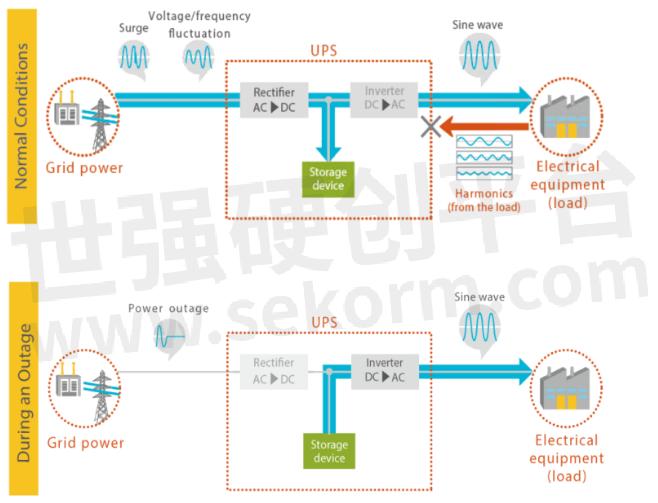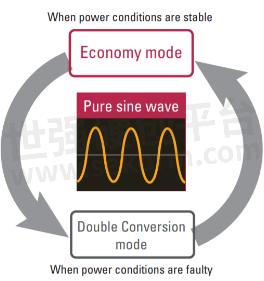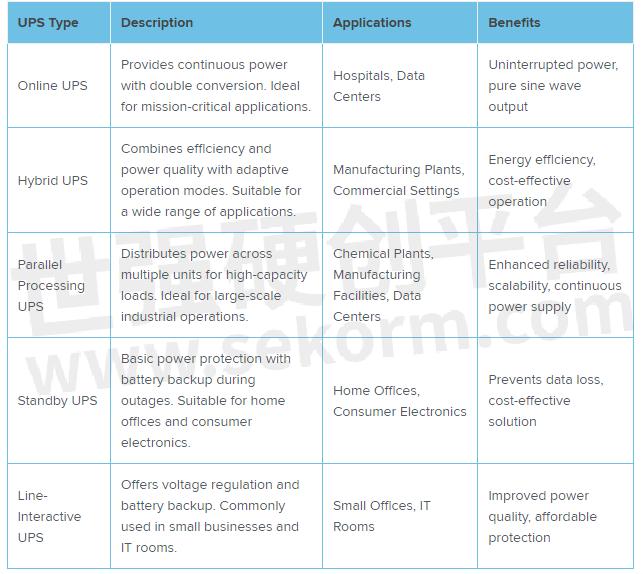A Comprehensive Guide to UPS Control Methods from SANYO DENKI


Uninterruptible Power Supplies (UPS) are essential for providing reliable power and protecting sensitive equipment from power disruptions. In this blog, we will explore the differences between the primary UPS control methods we offer: Online UPS, SANYO DENKI’s original Hybrid UPS, and Parallel Processing UPS which is mainly offered for Latin America. Additionally, we will provide insights into Line-Interactive UPS and Standby UPS to give readers a complete understanding of UPS topologies.
Online UPS: The Gold Standard in Power Protection
What is an Online UPS?
An Online UPS, also known as a double conversion UPS, is the most reliable and sophisticated UPS topology available. It continuously converts incoming AC power to DC, then back to AC, providing a pure sine wave output that is free from power disturbances. This double conversion process ensures that the connected equipment receives consistent and clean power, regardless of the quality of the incoming utility power.

How Does It Work?
The Online UPS accepts AC input, rectifies it to DC, and then inverts it back to 120V/208V AC to supply power to the load equipment. This continuous power conversion process eliminates power fluctuations and disturbances. A dual-directional circuit on the main board manages a rechargeable battery, which provides backup power during a blackout. The transition from the double-conversion circuit to the battery is seamless, ensuring uninterrupted power to the load.
Applications of Online UPS
Due to its superior reliability and power quality, the Online UPS is ideal for mission-critical applications where downtime is not an option. Industries such as data centers, healthcare, and manufacturing rely on SANUPS Online UPS systems to protect their sensitive equipment and maintain continuous operations.

Hybrid UPS: The Original Hybrid System
What is a Hybrid UPS?
SANYO DENKI’s original Hybrid UPS is an advanced system that combines the benefits of both efficiency and power quality. It incorporates an automatic operation mode selection, allowing the UPS to adapt to the power supply situation dynamically.

How Does It Work?
The Hybrid UPS prioritizes efficiency when the power supply is stable, optimizing energy usage and reducing electricity expenses. During unstable power supply conditions, it switches to the power supply quality priority mode, ensuring uninterrupted operation and maintaining power quality. This dual-mode operation makes the Hybrid UPS both energy-efficient and cost-effective.
Applications of Hybrid UPS

The Hybrid UPS is suitable for a wide range of applications, from commercial to industrial settings, where both energy efficiency and reliable power quality are crucial. It is particularly advantageous in environments with fluctuating power conditions, ensuring continuous operation and protection of sensitive equipment.
Parallel Processing UPS: Optimized for Latin American Markets
What is Parallel Processing UPS?
Parallel Processing UPS is designed to handle high-capacity loads by distributing the power across multiple UPS units. This setup ensures redundancy and reliability, as each unit can back up the others in case of failure.
How Does It Work?
In a Parallel Processing UPS setup, multiple UPS units are connected in parallel, sharing the load. This configuration enhances reliability and scalability, making it suitable for large-scale applications such as data centers and industrial facilities.
Applications of Parallel Processing UPS

Ideal for large-scale industrial operations such as chemical plants, manufacturing facilities, and data centers. It is especially beneficial in regions with frequent power fluctuations, like Latin America. SANYO DENKI’s Parallel Processing UPS ensures stable and reliable power for critical operations.
Standby UPS: Basic Protection at an Affordable Price
What is a Standby UPS?
The Standby UPS, also known as an offline UPS, is the most basic and cost-effective UPS topology. It provides power directly from the utility source and switches to battery power only when a power failure occurs.
How Does It Work?
Under normal conditions, a Standby UPS supplies power directly from the utility. When a power outage or disturbance is detected, it switches to battery power to keep the connected equipment running. However, this transition may cause a brief interruption in power, which can be problematic for sensitive equipment.
Applications of Standby UPS
Standby UPS systems are commonly used in consumer markets for small capacity demands (typically less than one kVA). They are affordable and provide basic protection for home electronics and small office equipment.

Line-Interactive UPS: Enhanced Efficiency with Voltage Regulation
What is a Line-Interactive UPS?
The Line-Interactive UPS topology offers a middle ground between the basic Standby UPS and the more robust Online UPS. It includes additional circuitry, such as a transformer or voltage regulator, to condition the incoming utility power and improve efficiency.
How Does It Work?
While similar to a Standby UPS, the Line-Interactive UPS features a transformer that helps regulate the voltage. This voltage regulation reduces the frequency of battery usage, extending the battery life and improving overall efficiency. However, it does not provide the same level of power conditioning as an Online UPS.
Applications of Line-Interactive UPS

Line-Interactive UPS systems are popular in the consumer and IT professional markets due to their balance of cost, efficiency, and reliability. They offer better protection than Standby UPS systems, making them suitable for small to medium-sized businesses and home office environments.
UPS Types Chart

SANYO DENKI’s commitment to quality and reliability is reflected in our preference for advanced UPS systems. Whether you need the unmatched protection of an Online UPS, the adaptive efficiency of a Hybrid UPS, or the scalability of a Parallel Processing UPS, SANUPS has the right solution for you. Understanding the differences between these UPS topologies helps you make an informed decision to ensure the best power protection for your specific needs.
- +1 Like
- Add to Favorites
Recommend
- Boost Reliability with SANYO DENKI SANUPS E33A and E23A Parallel Processing UPS
- SANYO DENKI Develops SANUPS E11B-Li Hybrid UPS Can Operate for 10 Years without Battery Replacement
- SANYO DENKI Develops 30 and 75kVA Models for High-Efficiency Online UPS SANUPS A23D
- Introducing the SANUPS A11M of SANYO DENKI: Reliable UPS With Parallel Redundancy
- SANYO DENKI Launches SANUPS A11M 100VAC Highly Reliable Parallel Redundant UPS To The U.S. Market
- SANYO DENKI Develops High-Efficiency Online UPS SANUPS A11N with an Output Capacity Expandable to 20 kVA
- SANYO DENKI Launches SANUPS A11M 100/200 VAC Highly Reliable Parallel Redundant UPS To The U.S. Market
- SANYO DENKI Develops SANUPS A11K-Li Online UPS with Li-ion Batteries With Wide Operating Temperature Range
This document is provided by Sekorm Platform for VIP exclusive service. The copyright is owned by Sekorm. Without authorization, any medias, websites or individual are not allowed to reprint. When authorizing the reprint, the link of www.sekorm.com must be indicated.





























































































































































































































































































































































































































































































































































































































































































































































































































































































